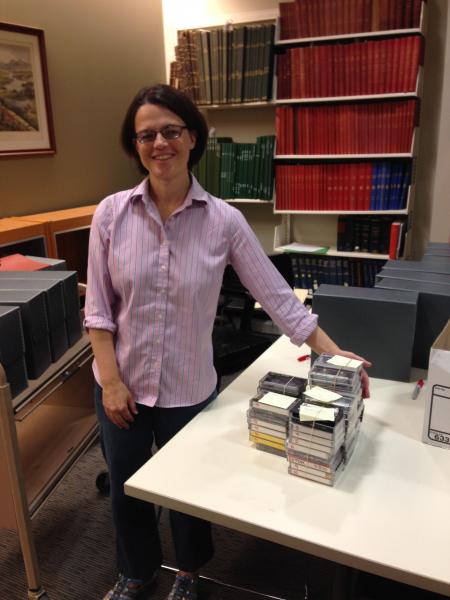A Year in the Life of Audiovisual/Media Preservation in Illinois: Anne Thomason's Story of Her Year
Audiovisual Materials at Lake Forest College Case Study, Anne Thomason
 Anne Thomason, College Archivist and Librarian for Special Collection at Lake Forest College
Anne Thomason, College Archivist and Librarian for Special Collection at Lake Forest College
Introduction/Summary
I eagerly began the project to inventory, assess, preserve, and provide access to the audiovisual materials held in Lake Forest College Archives and Special Collections. Over the summer of 2015, several researchers had requested audiocassettes of interviews, commencement DVDs, and videos of speakers on campus. I discovered over that summer that many of our VHS videocassettes no longer played, corrupted by time and inadequate storage conditions.
Overall, the inventory was the most successful stage of the year’s project. As the year progressed, the questions asked by our committee members became harder to answer—because I did not have the time for more than inventorying. The main takeaway is that I have learned most of our audiovisual materials are not properly stored and ideally we would migrate them to a digital format. One idea I had that I would like to be able to implement is to add migration to digital format as a part of the accessioning and processing workflow. At a minimum, I am updating our processing manual to include special care and consideration for audiovisual materials.
The good news is that with an inventory complete we can at least consider applying for grants to take care of these materials. However, are audiovisual materials the institution’s priority? Every project I take on needs to be balanced with the goals of the institution. Priorities right now include engaging our students in Special Collections and processing a number of collections most of which do not have audiovisual material. Thus, even though these materials need help, right now may not be the time to pursue grants in that particular area. Another perspective suggests we have the staff to help with instruction and teaching, but we do not have the staffing to take proper care of audiovisual materials—so perhaps that should be a priority for a grant project.
Inventory
Guided by the CARLI Blog, my first step was to inventory our collections. I enlisted student help. The first step was going through the collection as best I could to find collections of audiovisual material. It was easy to find several collections of oral history interviews, interviews with scholars, and interviews with guests on campus. Our collection of College videos was also easy to inventory; most of these items had labels. In some cases we checked the tapes to see what they were and spot-checked to see if they had correct labels. The harder thing, and that has yet to happen, is identifying materials that are a part of unprocessed manuscript collections. One outcome of this CARLI project is that I am now taking special care to identify any special needs for the audiovisual materials within a collection as that collection is processed.
Access and playability
Fortunately, we have several old cassette players and one portable stereo providing plenty of options to play audiocassettes. Cassettes that appear damaged are a concern. What will I do if they get caught in the player and twisted up? I don’t feel confident in fixing them if they have been damaged. At the excellent Audiovisual Preservation workshop sponsored by the CARLI Preservation Committee, I failed miserably at re-shelling a cassette! I could probably find a dexterous student worker to help with such work, but I fear we might do more damage than good. We also have a couple of VCRs for playing VHS tapes. I have yet to locate a Betamax player, and we do have a few items in Betamax format. I have not found any reel-to-reel tapes in our collections.
Migration
We want to migrate to digital format, yet doing so has not been simple. I thought our Technology Resource Center could help but scheduling the work proved to be difficult. I certainly could train student workers to migrate audio. However, there are other priorities the students are working on. Priorities include digitization projects, digitization on demand for researchers, and processing the manuscript collections and the College Archives material we have. Unless a researcher has requested digitization, finding the time and resources to digitize audiovisual materials may not be the best use of our time.
Future Steps
The task of assessing our audiovisual materials resulted in an awareness that audiovisual material needs to be handled differently from other types of materials, yet must also fit into our workflows. With all of our workflows currently being updated, why not find a way to process audiovisual materials properly? One change I can make is that I’m finishing writing a manual for processing collections at Lake Forest College. Because of this project, I will write what I think are doable best practices for processing audiovisual materials.
While I wish I could implement some of the tips provided by the Preservation Committee in the blog, and I wish I could say that after this year’s project our audiovisual materials are now stored perfectly and easy to provide access to all researchers, that is not the case. However, the inventory proved very useful and I now know what our strengths and our limitations are going forward.
Continue to the next article: Preservation Committee's Reflections of Our Year

